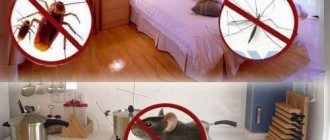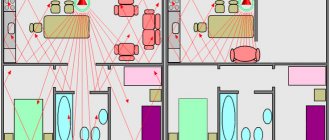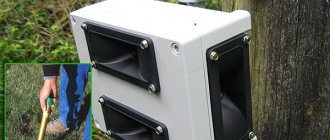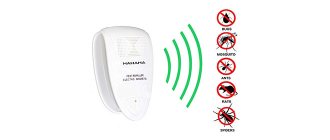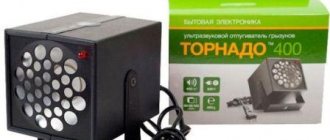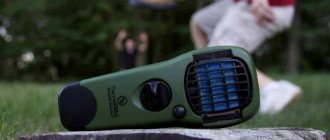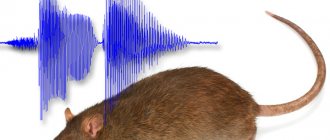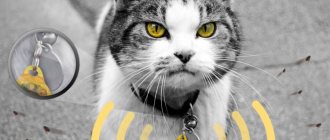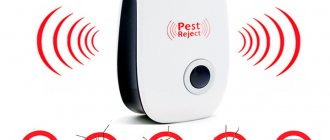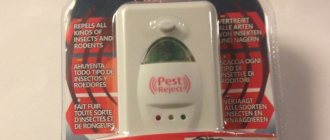Despite the attempts of city administrations to solve the problem, there are stray aggressive dogs running on the streets, from which serious troubles can be expected. They can not only scare a child and even an adult, but also bite and cause serious injuries as a result; this is a very important problem that must be resolved immediately by the city leadership. But it’s not the mayors who want to spend money on this. Therefore, it’s a good idea to buy or make your own circuit and use a powerful dog repeller. Look through the article and choose which scheme you will use to work with your own hands or order it from a master.
How to assemble an ultrasound generator
Some birds, as well as dogs, mice, rats, bats and other animals can hear sounds with frequencies up to 40,000 Hz.
The circuit proposed here emits continuous ultrasound at a frequency higher than that perceived by humans in the range between 18,000 and 40,000 Hz. The device can be used to treat dogs and other animals, in biological experiments and for many other purposes. The recommended piezo speaker delivers maximum output power in the frequency range between 700 and 3000 Hz; it will also operate at higher frequencies but with less power.
Recommended power sources are four AA batteries or one (battery or accumulator) 9 V. The current consumption is very low.
The circuit (Fig. 1) generates a signal with a frequency from 18,000 to 40,000 Hz, but you can easily change this range by selecting the capacitance of capacitor C1 or resistor R1. The range of capacitance C1 ratings is from 470 pF to 0.001 μF, the resistance of resistor R1 can be increased to 100 kOhm. The upper limit of the frequencies generated by the IC 4093 is 500 kHz.
The list of elements is given in the table.
The circuit can be placed in a small plastic case. The speaker is fixed to the front panel.
Ultrasonic generator 1. This circuit operates in the frequency range from 18 to 40 kHz
| Designation | Description |
| IC1 | CMOS 4093 integrated circuit |
| X1 | Piezo speaker or piezo earphone |
| R1 | Potentiometer or trim resistor, 22 kOhm |
| R2 | Resistor, 22 kOhm, 0.25 W, 5% |
| C1 | Film or ceramic capacitor, 1200 pF |
| C2 | Electrolytic capacitor, 100 µF, 12 V |
| S1 | Single pole switch |
| B1 | Four AA batteries (6 V) or rechargeable battery (9 V) |
Piezoelectric Langevin emitter
Paul Langevin
If a quartz plate is subjected to mechanical stress, it becomes electrified. And vice versa, if you change the electric field in which it is located with a certain frequency, then it will begin to oscillate with the same frequency.
What happens if you use electricity from a high-frequency alternating current source to charge the crystal? Having carried out such an experiment, Langevin was convinced that the oscillation frequency of the crystal was the same as the frequency of the voltage change. If it is below 20,000 Hz, the crystal becomes a sound source, and if it is higher, it will emit ultrasonic waves.
But the power of ultrasound emitted by one crystal plate is very small. Therefore, the scientist created a mosaic layer from quartz plates and placed it between two steel plates, which served as electrodes. To increase the amplitude of oscillations, the phenomenon of resonance was used. If the frequency of the alternating voltage supplied to the piezoelectric crystal coincided with its natural frequency, then the amplitude of its oscillations increased sharply.
This design was called the “Langevin sandwich.” And it turned out to be very successful. The radiation power was quite high, and the wave beam turned out to be narrowly directed.
Later, barium titanate ceramics, the piezoelectric effect of which is many times higher than that of quartz, began to be used as a piezoelectric element instead of quartz plates.
A piezoelectric plate can also be a sound receiver. If a sound wave meets it on its way, the plate will begin to oscillate with the frequency of the sound source. Electric charges will appear on its edges. The energy of sound vibrations is converted into the energy of electrical vibrations, which are captured by the receiver.
- < Back
- Forward >
Ultrasonic generator second option
Using two 4093 ICs, a powerful ultrasonic generator can be made as shown in the figure. The circuit uses a piezodynamic speaker or piezo-earphone with tens of milliwatts as a load. The generator operates in the frequency range between 18,000 and 40,000 Hz.
Ultrasonic generator 2
The frequency can be varied by changing the capacitance C2. The upper limit of the circuit frequency is 1 MHz.
The generator is suitable for conducting biological experiments related to the study of animal behavior and the conditions of their detention. Power supply: four AA batteries or a 9 V battery/battery. The circuit consumes only a few milliamps, and the battery life is up to several weeks.
A variable resistor with a nominal value of 47 kOhm can be connected in series with R1, which will allow you to adjust the frequency over a wide range.
The list of elements is given in the table. A high-frequency piezo speaker - tweeter - can be used as a loudspeaker. This component has a small output transformer inside it, as shown in the picture. You need to remove it.
List of elements of ultrasonic generator 2
| Designation | Description |
| IC1, IC2 | CMOS 4093 integrated circuit |
| X1 | Piezo speaker or piezo earphone |
| R1 | Resistor, 27 kOhm, 0.25 W, 5% |
| C1 | Electrolytic capacitor, 100 µF, 12 V |
| C2 | Ceramic or film capacitor, 0.001 µF |
| S1 | Toggle switch or button |
| B1 | Four AA batteries (6 V) or rechargeable battery (9 V) |
Transformer needs to be removed
Common faults
Unpleasant smell
The appearance of an unpleasant odor is a reason to check the performance of the piezo emitter
The appearance of a foreign odor indicates stagnation of water if the device has not been used for a long time and the water has not been drained. The cause may also be a clogged filtration system. Solution: complete cleaning of the device using special products, replacing filters.
No air supply
In the case when the humidifier is working, but no air flows, it is necessary to check the operation of the fan. The cause of the malfunction may also be a clogged air intake grille filter. Solution: replace the filter element or fan.
Doesn't turn on at all
If there is no power, the device becomes inoperable. If a problem is detected, check whether there is voltage in the line. This problem is also relevant when the plug fuse fails. Solution: replace the fuse, plug or wires.
Ultrasonic generator third option
This is the third version of the ultrasonic generator. A piezoelectric tweeter is used. The transistorized output stage provides a powerful output signal. The speaker, which is the load of the output stage, can produce an ultrasonic signal with a power of up to 400 mW.
The circuit is powered by four AA batteries or a 9 V battery/battery, the current consumption is about 50 mA.
The frequency can be set by resistor R1 in the range between 18000 and 40000 Hz. You can change the frequency by selecting the capacitance of capacitor C1. Values between 470 and 4700 pF can be selected experimentally.
Although the tweeter is most efficient between 10,000 and 20,000 Hz, this transducer has been experimentally proven to operate normally at frequencies up to 40,000 Hz.
Amplifier
The output stage is made using power transistors and, depending on the power of the ultrasonic generator, can be made using a push-pull circuit, a half-bridge circuit, or a bridge circuit.
Push-pull up to 100 W
In this circuit, the supply voltage is selected according to the condition E< Uk/2.
Where E is the supply voltage.
Uk is the maximum permissible voltage at the collector (or drain) of the transistor.
Half-bridge up to 300 W
Here the power supply is connected to a bridge, where the transistors are connected between the points marked "vg" in the diagram. In this case, the output transistor is connected to points “ab”. Transistors T1 and T2 are supplied with excitation pulses in antiphase from transformer Tr1. Since the supply voltage E drops across the transistor, it is required that E < Uk.
Bridged over 300 W
Here, the output stage of the ultrasonic generator is made of four transistors. The output transistor is connected to the “vg” diagonal, and the power source is connected to the “ab” diagonal. The base voltage is supplied to the shoulders of the bridge T1-T4 so that when T1 and T3 are open, then T2 and T4 are closed and then vice versa. This switching results in a fourfold increase in the power released to the load compared to the power supplied by one transistor. The supply voltage is selected from the condition E < Uk.
Addition of capacities
This scheme is used for high powers
The circuit operates on the principle of adding the power of half-bridge cells. The number of cells can be different and the more there are, the higher the output power. Power summation occurs at the output transformer Tr2. The supply voltage for this circuit is selected from the condition E< n*Uk.
- DIY fuel-free generators: diagram
- Voltage stabilizer circuit for 220 Volts
- A simple way to test an LED without desoldering it from the circuit
Powerful ultrasonic generator
This circuit can produce an ultrasonic signal of several watts using a piezoelectric tweeter or other type of transducer. The operating frequency is from 18,000 to 40,000 Hz, it can be changed by selecting the capacitance of capacitor C1. At large capacitance values, a signal will be generated in the audio range, which allows the circuit to be used in alarms and other devices. In this case, the tweeter can be replaced with a regular loudspeaker.
The circuit consumes several hundred milliamps from a 9 or 12 V power supply. Batteries are recommended for short-term operation only.
You can use this device to scare away dogs and other animals by installing it near garbage collection areas, etc.
Ultrasonic operating mode is achieved with capacitance C1 from 470 to 2200 pF. An audio signal requires a capacitance in the range of 0.01-0.012 µF.
The schematic diagram of a powerful ultrasonic generator is shown in the figure; the list of elements is given in the table.
Powerful ultrasonic generator. All transistors must be mounted on radiators
| Designation | Description |
| IC1 | CMOS 4093 integrated circuit |
| Q1, Q3 | Silicon npn transistor, TIP31 |
| Q2, Q4 | Silicon pnp transistor, TIP32 |
| SPKR | Tweeter or loudspeaker, 4-8 ohms |
| R1 | Potentiometer, 100 kOhm |
| R2 | Resistor, 10 kOhm, 0.25 W, 5% |
| R3, R4 | Resistor, 2.2 kOhm, 0.25 W, 5% |
| C1 | Film or ceramic capacitor, 1200 pF or 0.022 µF |
| C2 | Electrolytic capacitor, 100 µF, 12 V |
Transistors must be mounted on radiators. All components can be placed in a plastic case
Source
Equipment used
Considering the high cost of an ultrasonic welding machine, many home craftsmen are thinking about making the installation themselves. Unfortunately, this is not a welding transformer or even a rectifier, and designing and creating the device will require serious knowledge and skills in the field of acoustics and electronics. In addition, the manufacture of parts for the emitter and waveguide requires high-precision machines that are not available at home.
Ultrasonic Welding Press
Ultrasonic welding equipment is divided into three categories:
- chiseled;
- suture;
- suture-stepping.
Power range - 50 watts to 2 kilowatts, operating frequency around 20-22 kilohertz
The main unit of an ultrasonic welding installation is a vibration generator and a converter of electrical vibrations into mechanical vibrations of the same frequency.
Mechanical vibrations of the ultrasonic generator are converted by a magnetostrictive transducer. A water cooling system is used to remove excess heat
The waveguide transports the energy flow to the welding site. A replaceable welding head is mounted at its working end. Its geometric parameters are selected based on the material of the workpiece, its thickness and type of seam. So, to weld the pins of microcircuits, take a head ending with a thin tip.
Waveguide
The supporting frame serves to accommodate all components and parts. A mechanism for moving the workpiece or waveguide head is also mounted on it.
Basic ultrasound parameters
The main parameters of an ultrasonic wave are considered to be wavelength and period. The time required for a complete cycle is usually called the wave period and is measured in seconds.
The ultrasonic emitter is considered the most powerful generator of ultrasonic waves. A person cannot hear ultrasonic frequency, but his body is able to feel it. In other words, the human ear perceives ultrasonic frequency, but the part of the brain responsible for hearing is unable to decipher this sound wave. High frequencies are unpleasant for human hearing, but if you raise the frequency to another range, the sound will completely disappear - despite the fact that it is present in the ultrasonic frequency. And the brain makes efforts to unsuccessfully decode it, because of this a person experiences a terrible headache, dizziness, nausea and other not entirely pleasant sensations.
Methods of protection
To scare away wild and feral animals, various means are used. For example, a stationary ultrasonic dog repeller is used to protect houses and areas. The device allows you to leave your cottage or garden plot unattended while the owners are away. The operation scheme is similar to a portable device. Power is supplied from the network, and it starts working when the motion sensor is triggered. In addition to dogs, the device works as a repeller for cats, foxes, and rodents. The frequency of the sound changes so that the animals do not get used to it and continue to be afraid to enter the territory.
Most devices do not have a noticeable effect on humans. The most powerful models can cause headaches and ringing in the ears.
Electric shock is effectively used as a repeller. The sharp sound of the discharge and flash with the release of a large amount of ozone scare animals already at a distance of 10-20 m. It is often installed on a bicycle so as not to reach it while moving.
In addition to electronic ones, more traditional means of repelling dogs are also used, in particular, repellents and mixtures. The way they work is simple - they emit an unpleasant odor. After treating the area around the perimeter, animals will stop entering it. There is also a dog and cat version.
For tourists and athletes, it may be important to make a homemade dog repeller. It is an analogue of a gas cylinder. Consists of a container into which a mixture of vinegar and pepper is placed. This option is inhumane, but very effective. Other mixtures are also used, in particular, based on shag.
You can make a homemade ultrasonic repeller if you don’t trust the effectiveness of the devices being sold. This will require some knowledge of electrical engineering.
Sometimes the best defense is an attack. If you don’t have the device at hand, and you are surrounded by an angry flock, you can simply bend down to the ground and pretend that you are picking up and throwing a stone. This technique will scare away the dogs. Dogs are animals, they are devoid of reason, and instinct makes them afraid of such gestures.
Why do strawberries, strawberries and berries dry out and die during the fruiting period: reasons, what to do, what to spray with? Why do the leaves, leaf edges, buds, berries of recently planted strawberries and strawberries in the garden turn yellow, blacken, and dry out: diseases, pests, improper care
Types of ultrasonic waves
Ultrasonic waves are not only transverse or longitudinal, but also surface and Lamb waves.
Transverse ultrasonic waves are waves that move perpendicular to the plane of the direction of velocities and displacements of body particles.
Longitudinal ultrasonic waves are waves whose movement coincides with the direction of the velocities and displacements of particles in the medium.
A Lamb wave is an elastic wave that propagates in a solid layer with free boundaries. It is in this wave that the oscillatory displacement of particles occurs both perpendicular to the plane of the plate and in the direction of movement of the wave itself. It is the Lamb wave that is a normal wave in platinum with free boundaries.
Rayleigh (surface) ultrasonic waves are waves with elliptical particle motion that propagate on the surface of a material. The speed of a surface wave is almost 90% of the speed of a transverse wave, and its penetration into the material is equal to the wavelength itself.
Advantages of the device
Repelling mice with ultrasound has a number of advantages:
- no need to search for and remove the carcasses of dead rodents;
- there is no danger of poisoning pets with poisons;
- safe for people;
- works throughout the room, no need to update baits.
The electronic device repels not only rats and mice, but also many insects. In parallel with rodents, you can remove ants, cockroaches, and spiders from the house.
A properly assembled homemade ultrasonic mouse repeller works no worse than a factory one, but has its drawbacks. A more effective option is a combined version of the device that generates both ultrasonic and electromagnetic waves.
Using Ultrasound
As mentioned above, the diverse use of KM, in which a variety of its characteristics are used, can be divided into three areas:
- receiving the information;
- active influence on the substance;
- signal processing and transmission.
It should be taken into account that for each specific application it is necessary to select ultrasound of a certain frequency range.
Printed circuit board
Due to the impossibility of manufacturing a printed circuit board for a mole repeller using chemical technology, a mechanical method was used to remove sections of copper foil from foiled fiberglass laminate.
The location of radio components on the printed circuit board of the mole repeller is shown in the photo below.
The appearance of the printed circuit board for manufacturing by photochemical method and the location of radioelements is shown in the photograph below.
The board can be made from 1.5 mm thick fiberglass foil on one side.
A site visitor, who introduced himself as San Sanych, kindly provided his version of a rodent repellent printed circuit board, laid out in the graphic editor for PCB layout Sprint-Layout 3.0R, for which many thanks to him.
Assembling an ultrasound circuit for repelling dogs
Many residents of the country's megacities daily face the rather tangible problem of encountering a pack of stray dogs. It is impossible to predict the behavior of a flock in advance, so the UZG will come to the rescue here.
In this article we will show you how to make an ultrasonic generator with your own hands.
To create an ultrasound at home, you will need the following parts:
- printed circuit board;
- world schema;
- radio engineering elements.
Assembling the circuit yourself will not be difficult. In order to be able to control the pulses, you should attach the radio component to specific legs of the microcircuit using a soldering iron.
Let us analyze the design of a high-power ultrasonic frequency generator. The D4049 microcircuit, which has 6 logical intertors, works as an ultrasonic frequency generator.
A foreign microcircuit can be replaced with a domestically produced analogue K561LN2. To adjust the frequency, a 22k regulator is required; with its help, the ultrasound can be reduced to an audible frequency. Thanks to 4 biopolar transistors with medium power, the output stage receives signals from the microcircuit. There are no special conditions for choosing transistors; the main thing here is to choose complementary pairs that are as close as possible in terms of parameters.
Correct use of the repeller
It is important not only to assemble the repellent device correctly, but also to know how to use it. If a dog or a pack of animals behaves aggressively, the actions should be sharp and unexpected. The repeller should be used as follows:
- remove the device from your bag or pocket;
- wait until the dog approaches at a distance of about 1 m;
- point the repeller at the dog;
- activate the product by pressing the button.
When the animal retreats briefly, you need to continue pointing the ultrasound device at it. When the dog moves more than a meter away, the device should be turned off. They do this so that the dog gets a little used to it. If you turn it on again, the effect will be stronger. When you press the button of the device, it is enough to direct the sound towards your head.
Having looked at different designs for a powerful dog repeller, as well as how to make the device yourself using step-by-step instructions, you will be able to select and assemble the most suitable option. Using inexpensive and accessible components and having minimal knowledge in radio electronics, you can design a device that will work no worse than factory products, and with careful installation even surpass them in reliability.
Author: Vladimir
Ultrasonic generator circuit
In the modern world, it is customary to use an ultrasonic generator to repel dogs, insects, rodents, as well as for high-quality washing. Ultrasonic gas is also used to significantly reduce the time required for washing and etching printed circuit boards. Chemical processes in liquids proceed much faster due to cavitation.
The UG circuit is based on two rectangular pulse generators and a bridge-type power amplifier. On logic elements of type DD1.3 and DD1.4 a tunable generator of ultrasonic frequency pulses with a meander shape is installed. It should be remembered that its operating frequency directly depends only on the total resistance of resistors R4 and R6, as well as on the capacitance of capacitor C3.
Remember the rule: the lower the frequency, the greater the resistance of these resistors.
A low-frequency generator is made on elements DD1.1 and DD1.2, which has an operating frequency of 1 Hz. The generators are connected to each other using resistors R3 and R4. In order to achieve a smooth change in the frequency of the high-frequency generator, you need to use capacitor C2. Here you should also remember one secret - if capacitor C2 is bypassed using switch SA1, then the frequency of the high-frequency generator will become constant.
Models with unijunction capacitors
How to make an electric current generator at home
Devices of this type are capable of providing conductivity at a level of 5 microns. They have quite high sensitivity. The rods on the ultrasonic emitter are installed with a diameter of 2 cm. The windings are used only with rubber rings. Dipole terminals are used at the bottom of the devices. The total resistance level when loaded is 5 ohms. Capacitors are allowed to be installed on emitters through expanders. Adapters are used to extend low frequencies.
If necessary, you can make a modification to two capacitors. For this purpose, the terminals are installed with a conductivity of 2.2 μm. The rod is selected with a small diameter. It should also be noted that a short stand made of aluminum alloy will be required. Electrical tape is used as insulation for the terminals. Two rings are attached to the top of the emitter. The capacitors are mounted directly through a dipole expander. The total resistance level should not exceed 35 ohms. The sensitivity depends on the conductivity of the terminals.
The use of ultrasound: the widest range of applications
As we all know, ultrasound is not used anywhere in the modern world. Surely each of us has undergone an ultrasound (ultrasound) procedure at least once in our lives. It should be added that it is thanks to ultrasound that doctors can detect the occurrence of diseases of human organs.
Ultrasound is actively used in cosmetology to effectively cleanse the skin not only of dirt and fat, but also of epithelium. For example, ultrasonic phonophoresis is successfully used in beauty salons both for nutrition and cleansing, and for moisturizing and rejuvenating the skin. The technique of using ultrasound phonophoresis strengthens the protective mechanisms of the skin due to the action of the ultrasonic wave. Cosmetic procedures using ultrasound are considered universal and suitable for all skin types. Ultrasonic phonophoresis performs miracles!
The ultrasonic steam generator is actively used not only in Turkish hammams and Finnish saunas, but also in our modern Russian baths. Thanks to steam, our body is effectively cleansed of invisible dirt, our body gets rid of toxins and waste, skin and hair are healed, steam has a positive effect on the human respiratory system.
Artificial fog generators are actively used to increase indoor air humidity, which has a beneficial effect on the climate in the apartment. This becomes especially relevant in the cold season, when centralized heating dries out the air. Artificial fog generators are used both in residential premises and in terrariums or winter gardens. Experts advise having an ultrasonic fog generator for people with respiratory diseases or those prone to allergic diseases.
What is it for?
The scope of application of the bath is wider than you might imagine. Larger ultrasonic units are used in enterprises to clean large parts, tools, and workpieces. There are ultrasonic baths even for washing clothes, washing dishes, and processing vegetables. An ultrasonic emitter is built into many models of modern washing machines. Household bathtubs are often purchased to wash parts, circuit boards, jets and jewelry.
For cleaning injectors
An injector is a mechanism that is a simple electromagnetic valve that meters the supply and atomization of fuel (it must do this as accurately as possible). It is difficult to clean clogged nozzles, but an ultrasonic bath copes with this task. If necessary, the injector with nozzles is removed and washed with waves at a gentle frequency, repeating the procedure several times.
- How to pickle garlic arrows for the winter
- What is Zhiber's pityriasis rosea and how to cure it: photo
- How to cook lentils
For phones
A phone that has fallen into water can be saved by washing the motherboard with ultrasound of a certain frequency. For this procedure, technical services also use a household cleaning bath. The technician will remove the board, remove parts from it that are harmful from contact with water (camera, speaker, microphone), lower it inside the bath, fill it with a special solution and turn on the device to operate at a given frequency. The board will be cleaned by air bubbles, and the functioning of the phone will be restored.
For washing parts
An ultrasonic bath can be used to clean optics, metal, and other solid parts from dirt, foreign components, traces of soldering or grinding. The device is used for cleaning components and parts of office equipment (excellent for washing printer heads, increasing their service life). Jewelry makers really appreciate a bath with ultrasound. Even items that are heavily soiled during wear become absolutely clean after a few minutes of treatment.
